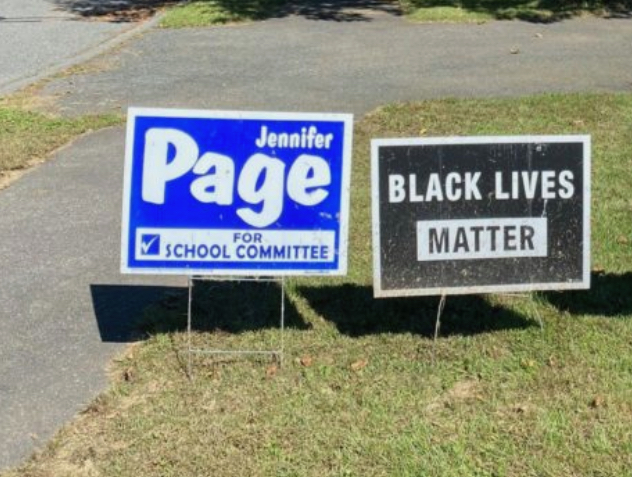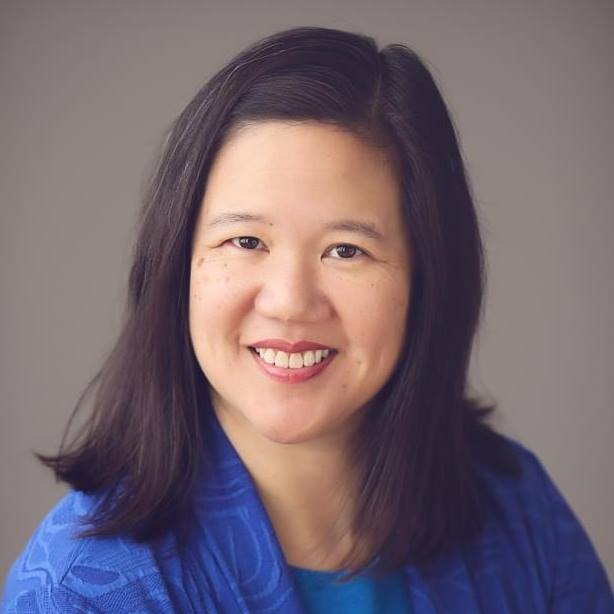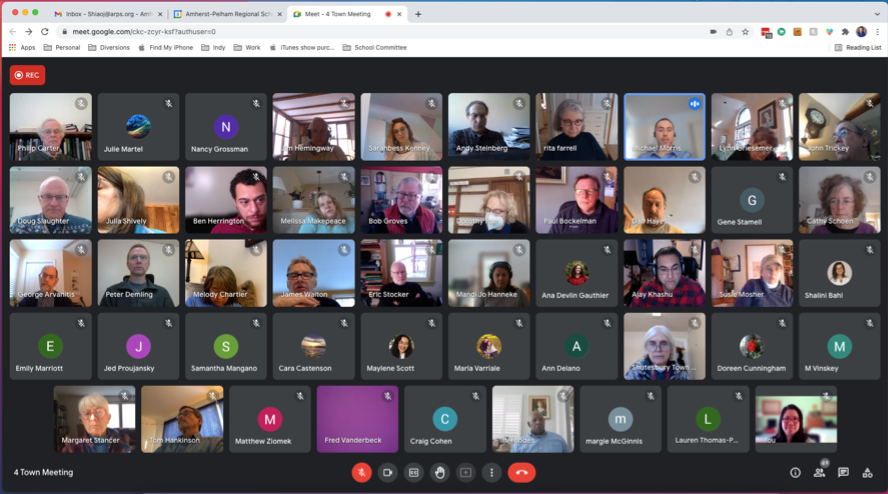Opinion: Jennifer Shiao’s School Committee Blog. My Second First Meeting

Photo: Jennifer Shiao
Editor’s note: Beginning this week the Indy will post Jennifer Shiao’s School Committee Blog on Wednesday Mornings.The Wednesday posting will include all new posts to the blog since the previous Wednesday. Shiao’s original posts can be found here. An archive of her blog posts in The Indy can be found here.

My Second First Meeting (Amherst School Committee Meeting: 1/11/22)
January 11 was my first meeting of the Amherst School Committee. (If you’re thinking, didn’t I already have a “first meeting,” check out my Amherst has two school committees? blog post.)
As with the Regional School Committee meeting last week, the first order of business was electing officers. Allison McDonald was nominated, ran unopposed, and was elected unanimously to chair. For the vice chair position, Irv Rhodes and I were both nominated, with Irv getting more votes. Voting for Irv were Peter Demling, Allison McDonald, and Irv. Ben Herrington and I voted for me.
Finally, the secretary position. The secretary of the Amherst School Committee (along with the chair and vice chair), sits on the Union 26 committee, for the purposes of employing the superintendent, along with the Regional School Committee (see Amherst has two school committees?for more info on Union 26). Peter and I were both nominated, with Peter winning with the same votes as Irv (Peter, Allison Irv). (Ben and I voted for me.)
Observations
- The Amherst School Committee is now allowing members of the public to make public comments in real time, by joining the Google Meet. This is a change to the past practice up until now, which was that people could only give public comments by voicemail or email. I’m pleased that the School Committee is now allowing members of the public to join the Google Meet and give public comments “live.”
- I asked Allison, in her role as the chair, to consider varying the order that she calls on members when doing a roll-call vote. I have noticed that the Town Council president calls on people in alphabetical order, but varies who goes first. In the past, Allison as the school committee chair has called on members in alphabetical order, with the same person going first every time. She seemed amenable to the idea, and in fact did vary the order later in the meeting. I think this a more fair and equitable way to take roll-call votes.
- In Superintendent Mike Morris’s update, he shared that due to last Friday’s snow day, the session that had been planned for collecting input from current 6th graders on moving 6th grade to the middle school had to be rescheduled. I’m very pleased that the process for figuring out the best way to manage and implement moving 6th graders to the middle school is starting out by going right to 6th graders. I think they will have some valuable insight into how to manage the move in the best way for students.
- The committee discussed a draft document called “Amherst School Committee Norms 2022,” which summarizes the policies on School Committee Governance and Operations (Section B of the ARPS Policy Manual). This proposed two-page document lays out bullet points on how the school committee carries out its responsibility, with reference back to the specific policies in Section B. I questioned why we need a document that summarizes another document. Everything in the document looked reasonable, but I didn’t think we needed to spend time reviewing and approving a document that summarizes our existing policies. Peter seemed to agree with me on this, saying “I see no need to group wordsmith a summary document.”
- Mary Kiely, ARPS coordinator of curriculum, instruction, and assessment, and Stephanie Joyce, ARPS title 9 coordinator, presented the initial work of the K-5 Math Curriculum Review committee. This committee is tasked with identifying and recommending a new math curriculum for grades K-5. After a selection process and a six-week pilot of two finalist curricula, they will make a recommendation to the superintendent around the end of April. I shared that I hoped that in choosing the new curriculum we would have an eye towards developing students who will grow up to be adults who are not afraid of math! As a math major myself, I have often been perplexed by adults who are afraid of math, or claim they are not good at math – I think it probably goes back to their own K-12 math experience, and I have higher hopes for the current generation of students! Ben shared a story about his son’s reaction to a clumsy attempt at “diversity” in a math word problem that his son said was “so corny” and asked if input would be gathered from students on the proposed new curriculum. Mary responded that the curriculum would be piloted in a 2nd grade class, with teachers trained on the new curriculum. “This is equity work” choosing a high quality curriculum.
- Mike gave an update from the Elementary School Building Committee (ESBC). Two workshops will be held this month, to engage the community about the education plan and vision for the new school building, as well as for elementary education in Amherst overall. The education plan will be developed and presented to school committee on February 8, then we anticipate voting on it on February 22 (at an extra/additional meeting). I asked if these two sessions are the only opportunities for members of the public to give input (yes), then suggested other venues for collecting input. I offered to contact Cathy Schoen (Amherst town councilor and chair of the ESBC) and Phoebe Merriam (ESBC member) to develop other ways for the public to give input. This education plan will be relatively high level, and there will be opportunity in the future for input on more detailed things, like building layout.
- In the Safety and Health update, Mike shared that the district is making sure teachers can work from home on teacher curriculum/work days if they prefer, and focusing on lightening the load for non-teaching work, which he referred to as “non-core work” (the core work being teaching!).
- We reviewed a proposed survey to be sent to community members about the school budget. I suggested it should have mostly open-ended questions, and that we treat it as an intention to gather qualitative information, not quantitative data. Asking something like “What creative ideas do you have for making budget cuts in a way that minimizes direct impacts on students?” could generate some new and fresh ideas. I also think it’s important that people can submit it anonymously.
- I volunteered to be one of the two school committee representatives on the JCPC (Joint Capital Planning Committee), a body made up of representatives from the school committee, library trustees, and town council. The JCPC is tasked with producing a written report on recommendations for capital spending. Irv also volunteered.
Four Towns Walked Into A Bar … (1/10/22)
A “Four Towns” meeting was held on Saturday, January 8. This meeting was hosted by the Amherst Regional School Committee and invites individuals and bodies from the four towns (Amherst, Leverett, Pelham, and Shutesbury) to view, ask questions, and give input on the regional school district’s proposed budget for the next fiscal year. The folks invited are: School Committee, Select Board or Town Council, town Finance Committee, town manager.
Over 50 people attended the January 8 meeting, and I figured out how to see them all on my screen at once in Google Meet!
The regional school district (Amherst Regional Middle School and Amherst Regional High School) is funded by the four towns, with each town contributing an amount based on a formula. The commonwealth of Massachusetts dictates a formula that is referred to as “the statutory method.” This method takes into account each town’s “ability to pay” which is based on property values in the town. Despite the fact that “statutory” means required, a region can choose to use a different method, as long as all participating towns agree (it also needs to be approved by the commissioner of elementary and secondary education). The state refers to any other method as an “alternative method.” Here at ARPS we refer to our alternative method as “the regional agreement.” If a region uses anything other than the statutory method, it must be voted on every year (even if it’s the same as the prior year), and all four towns must vote in favor. This is a critical part of passing the budget.

For many years now there has been tension between using the state’s statutory method or our custom “regional agreement,” which is based on student enrollment (five-year rolling average of students enrolled from each town).
Between 2008 and 2016, the “regional agreement” was used; in 2017, the four towns agreed to use a mix of the two methods: 30% by the statutory (ability to pay) method and 70% by the regional agreement (student enrollment) method. The goal was to slowly increase the % statutory method to ease the transition of changing formulas. For FY22 the formula is 65% statutory and 35% regional agreement.
Confused yet? Me too. Basically, the way I think about this is that for some towns, it’s better for them if they pay an amount based on their property values, and for other towns it’s better for them if they pay an amount based on the number of students they send to the regional schools. Right now, the assessment method (that is, the formula used) is a combination of the two (65/35).
Doug Slaughter, the ARPS finance director, presented various formula options, from 55% statutory to 100% statutory. Representatives from each town had the opportunity to speak and give their input.
Andy Steinberg from the Amherst Town Council said that in the last five years (during the period that the % statutory portion of the formula has gotten bigger), Amherst’s contribution has gotten bigger while the contributions from the other three towns has gotten smaller. He implied that moving towards a greater % statutory portion is not sustainable for Amherst. He went on to say that people view Amherst as the big town with plenty of resources, but that 50% of property in the town is owned by UMass and other colleges, and another 30% is not taxable for other reasons, so a huge portion of town real estate is not taxable, and yet we have a sizable population that the town provides services for. This is not news to me, but I appreciated hearing it stated so simply. People think that high property values in Amherst mean that Amherst has plenty of money, but in fact a huge proportion of real estate within the Amherst borders does not bring in any property tax revenue.
A representative from Shutesbury said that their goal is to move to the 100% statutory method, which they believe is the most fair and equitable because it factors in the “ability to pay.” Interestingly, this is the option that would result in Shutesbury paying the least amount, among all the options. A representative from Leverett said that they prefer the regional agreement method because it is based on a dollar contribution per student from that town. The Leverett person said they feared if Amherst could not shoulder the burden of the statutory method, that the quality of education would suffer. Similarly with Shutesbury, Leverett’s preferred option is one of the lowest in terms of the total amount Leverett would pay.
I spoke up and suggested an exercise whereby representatives from each town would pretend to represent another of the four towns, and go through the process of determining the optimal formula from that other town’s perspective, in an effort to get people to see things from someone else’s perspective.
This discussion will continue as the budget process unfolds in the coming weeks and months.
Visioning Of Elementary Education In Amherst (1/9/22)
There are two Zoom workshops coming up that will allow community members to give input and participate in the visioning of the future of elementary education in Amherst, including goals and priorities for the new elementary school building.
The Zoom link can be found here.
Also, see the January 7 Superintendent’s update email, or check out the event listings below:
Jan 13, 8:30 – 11:30 AM
https://www.facebook.com/events/4449258331866533?ref=newsfeed
Jan 26, 6:00 – 9:00 PM
https://www.facebook.com/events/494635375355611?ref=newsfeed
Amherst Has Two School Committees? (1/7/22)
I thought it would be helpful to have a short primer on school committees in Amherst.
Every two years (in odd-number years), Amherst voters elect five School Committee members to two-year terms. All five seats are up for election at the same time, in the same election as other town offices, such as Town Council and Library Trustee.
These five officials make up the Amherst School Committee, the body that oversees Amherst’s three elementary schools: Crocker Farm, Fort River and Wildwood. This body meets around once per month, and has a chair, a vice chair, and a secretary*. (The Pelham, Leverett, and Shutesbury elementary schools are not under the purview of this body; those towns have their own school committee for their elementary school.) The Amherst School Committee is sometimes informally referred to by people as “the elementary school committee.” (To further complicate matters, there is also an Elementary School Building Committee, which is a different body.)
The five Amherst School Committee members are also members of the Amherst-Pelham Regional School Committee. This body oversees the Amherst Regional Middle School and the Amherst Regional High School. Because these two schools also draw students from Leverett, Pelham, and Shutesbury, the Regional School Committee also includes members from those three towns (one each from Leverett and Shutesbury, two from Pelham), for a total of nine members. This body meets around twice per month, and has a chair, a vice chair, and a secretary (the secretary is typically a note-taker who is not a member of the committee).
The Amherst School Committee makes decisions on issues affecting the three elementary schools, and the Regional School Committee on the middle school and high school. For district-wide policies that affect both the elementary and middle/high schools, votes may have to be taken in both school committees. That’s why sometimes you may hear about an upcoming vote taking place and you think, Wait didn’t that vote already happen? It may be because it was voted on in one school committee, and then has to be voted on in the other. The school committees hold separate meetings.
* Further confusing this issue is the Union 26 School Committee, which is made up of the chair, vice chair, and secretary of the Amherst School Committee, and three officers from the Pelham School Committee. The Union 26 School Committee is tasked with employing the superintendent jointly with the Regional School Committee.
Clear as mud, right? If you’re confused, don’t worry – you’re not alone. Everyone finds it confusing at first; it took me several years of reading news, watching meetings, and asking questions, before I figured it out!
This blog reflects my own views about the Amherst and Amherst-Pelham Regional School Committees – it does not represent the view of the committees, the district, or the superintendent. This blog complies with Open Meeting Law, as long as a quorum of School Committee members do not engage in deliberations in the comments. Comments are welcomed; commenters must register with their name and email address (email address will not be published). I may respond to comments, but I will not respond to all comments. Sign up here using the “follow blog via email” form to be notified when I post a new entry.

This is so great! Informative and clear. Thank you for posting and serving.
Thanks for serving Jennifer and this super informative report!
“I spoke up and suggested an exercise whereby representatives from each town would pretend to represent another of the four towns, and go through the process of determining the optimal formula from that other town’s perspective, in an effort to get people to see things from someone else’s perspective.”
This is brilliant, Jennifer – thanks for sharing, and even more thanks for serving so thoughtfully!